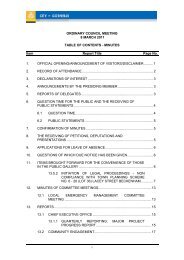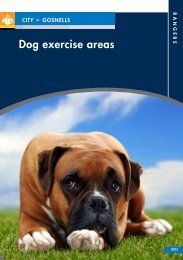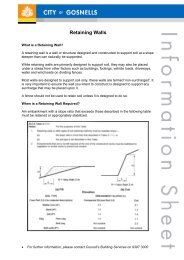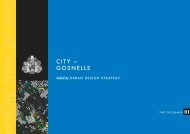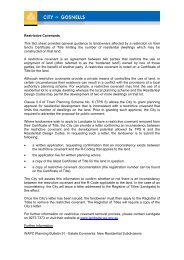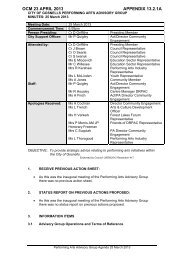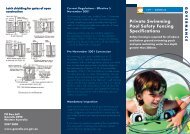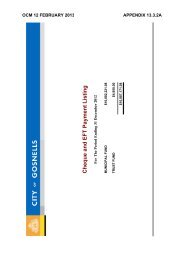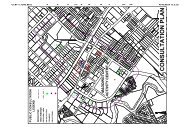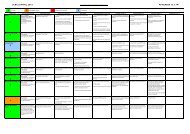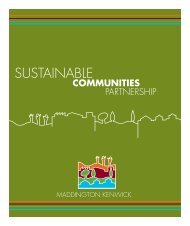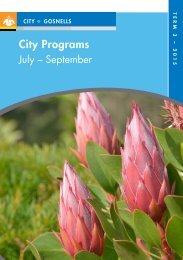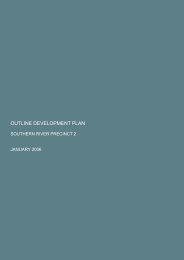Summary - City of Gosnells
Summary - City of Gosnells
Summary - City of Gosnells
You also want an ePaper? Increase the reach of your titles
YUMPU automatically turns print PDFs into web optimized ePapers that Google loves.
Vegetation 721.SitesQ=quadratR=relevé2.VegetationCondition3.Dendrogram(’DEN quads’from App. C, p.10, Table 2)4.Nearest NeighbourAnalysis (‘NNB’from Appendix C, p.10, Table 2)5.<strong>Summary</strong>fromAppendixC6a.FCT(s)suggestedby totalevidence25R degraded 24/23a 24/23a 23a26R good 3a ?3c ?3c ML27Q good 11/14 ??11/6/9 ??11/6/9 ?28Q very good 3a ?3a/4 ?3a/4 3a29R degraded 23b/24 23b/24 23a30R good inferred 3a31R degraded inferred S2/?10a32R good-degraded inferred ?8/10a6b.ConservationValueNote 1: Sites 14R, 24R and 26R went through the multivariate analysis as quadrats, although they are relevés.Note 2: The colours in Column 6a indicate Groups:A B C D E FNote 3: The colours in Column 6bindicate, respectively, an EPBC-listed TEC, a WA DEC-listed TEC, or a DegradedFCT &/or FCT 23a (these are the colours used in an FCT map to show the conservation status <strong>of</strong> the FCTs)Site 4 was unusual in Group C as its nearest neighbours in the SCP sites were Sites 8, 13 and 10 in theMKSEA and MUD-5 (FCT 3a), Site 11 <strong>of</strong> the MKSEA, YULE-4 (10a) <strong>of</strong> the SCP dataset, Sites 1 and 12 <strong>of</strong>the MKSEA, TWIN-2 (FCT 6) and ELLEN-5 (FCT 8) <strong>of</strong> the SCP dataset. Site 4 was located in palusplainand the vegetation and was very species-rich and in good to very good condition. It included severalcalcicole species (Gahnia trifida, Thysanotus arenarius and Tricoryne elatior) and was underlain by ashallow Muchea Limestone aquifer (Appendix C). The ambiguity associated with Site 4 with regard to theFCTs <strong>of</strong> the SCP was probably due to the presence <strong>of</strong> the Muchea Limestone. Other sites in the MKSEA thatshowed high similarity with Site 4 in the NNB were Sites 8, 10, 11, 12, 13 that also included a numbers <strong>of</strong>calcicole species (Gahnia trifida, Melaleuca brevifolia, Samolus junceus, Wilsonia backhousei) althoughshallow hardpans at these sites prevented a thorough investigation <strong>of</strong> the stratigraphy and hydrology.Sites 5, 6, 14 and 21 <strong>of</strong> the MKSEA were the sites in Group B that were most similar to the habitat describedfor FCT 7 in Gibson et al. (1994) as they were the sites that had the most persistent standing water in winterand spring. They also included aquatic species and/or emergent macrophytes that are a hallmark <strong>of</strong> FCT 7(e.g. Amphibromus nervosus, Baumea arthrophylla, *Cotula coronopifolia, *Crassula natans, Lepyrodiaglauca, Triglochin linearis, Utricularia spp., Villarsia capitata) in or adjacent to the sites surveyed.However, the habitat <strong>of</strong> these areas in the MKSEA was best described as floodplains (seasonally inundatedflats) rather than the sumplands or claypans that are typical <strong>of</strong> FCT 7.Site 5 in the nearest neighbour analysis was atypical as it had high similarity to sites at Paganoni Swamp(FCTs 17 and 13 from Spearwood Dunes with Tamala Limestone) in the SCP dataset; Sites 21, 4 <strong>of</strong> theMKSEA (that both showed evidence <strong>of</strong> Muchea Limestone); Site 1, another site adjacent to Yule Brook inthe MKSEA; and cool-11 (FCT 11, Quindalup Dunes and calcareous mud). The stratigraphy and hydrology<strong>of</strong> Site 5 was not investigated in detail; however, there were calcicole species in and adjacent to Site 5(Casuarina obesa, Gahnia trifida, Melaleuca brevifolia, Samolus junceus, Tricoryne elatior, Wilsoniabackhousei) and small pieces <strong>of</strong> limestone evident in firebreaks in this area.Site 21 in the NNB was most similar to Sites 5, 20 and 10 in the MKSEA and PAGA-5 (FCT 17) inPaganoni Swamp (Spearwood Dunes with Tamala Limestone) in the SCP dataset, Site 4 (MucheaLimestone), MTB-5 (FCT 17) and cool-11 (FCT 17 from Spearwood Dunes with Tamala Limestone)) <strong>of</strong> theSCP. Site 21 was inhabited by the rare calcicole species Eremophila glabra subsp. chlorella and othercalcicoles (Melaleuca brevifolia and Gahnia trifida) and was adjacent to Site 20 where calcareous materialwas noted in the shallow sediments.Sites 8 and 11 <strong>of</strong> the MKSEA were palusplain areas where a shallow hardpan limited the investigation <strong>of</strong>sediments and hydrology. Neither <strong>of</strong> these areas had standing water in winter and spring or aquatic species;the habitats were more akin to those <strong>of</strong> FCT 10a than FCT 8.Sites 9, 10 and 20 <strong>of</strong> the MKSEA were all palusplain areas where a shallow hardpan limited the investigation<strong>of</strong> sediments and hydrology. None <strong>of</strong> these areas had standing water in winter and spring or aquatic species;the habitats were more akin to those <strong>of</strong> FCT 10a than FCT 8. These sites included a number <strong>of</strong> calcicolespecies (Gahnia trifida, Melaleuca brevifolia, Samolus junceus, and Wilsonia backhousei) that suggestedTauss, C. and Weston, A.S. (2010). The flora, vegetation and wetlands <strong>of</strong> the Maddington-Kenwick Strategic Employment Area.A survey <strong>of</strong> the rural lands in the vicinity <strong>of</strong> the Greater Brixton Street Wetlands. Report to the <strong>City</strong> <strong>of</strong> <strong>Gosnells</strong>, W.A. Version 18.04.10



